JCG
100 W
- Joined
- Nov 10, 2008
- Messages
- 174
Hi all, after posting for a while in the ebike area regarding a through-the-road parallel electric bike with an ultracapacitor storage buffer (http://www.endless-sphere.com/forums/viewtopic.php?f=6&t=7511), it's time to start floating information and calling on advice and ideas regarding a longer-term project that I hope to kick into high gear this summer.
I've written a bit about this in other places, but a few years before I took my current position, my University was donated an EV-1 electric vehicle by General Motors. We have been trying very hard to get a place to work on the car, and may finally have caught a break for starting work this summer. The project I'm overseeing has a limited amount of funding, but it centers on converting the EV-1 into a serial hybrid with an ultracapacitor bank as its electric storage buffer. The main (average level) power source will be a genset powered by a to-be-determined fuel - likely biodiesel, which we are going to make by recovering waste vegetable oil from campus dining services. I am also considering ammonia fuel. In general, the energy flow plan is:
Liquid fuel --> Generator set --> Rectifier --> Ultracap Bank (389 V, 20.6 F) <--> AC motor controller <--> 3-ph, 103 kW motor
In order to get students interested in the project while our garage facility is prepared, I have used existing supplies (purchased and scavenged) to make a model of the proposed series drivetrain. Here is an introduction to the scaled setup.
The genset, when in operation, will provide either 1 or 3 phase AC power which must be rectified to DC. I have saved a 220V, 1.7 kVA variac from the junk heap to serve as this source of AC. It will deliver single phase AC in a voltage range of 0 to 220 VAC, RMS (the outlet's voltage level). I have connected its outputs (white and orange) to a 20 A rectifier, mounted on a large aluminum plate (heat sink). It provides DC output, which will give up to about 311 VDC when connected to a capacitive load.
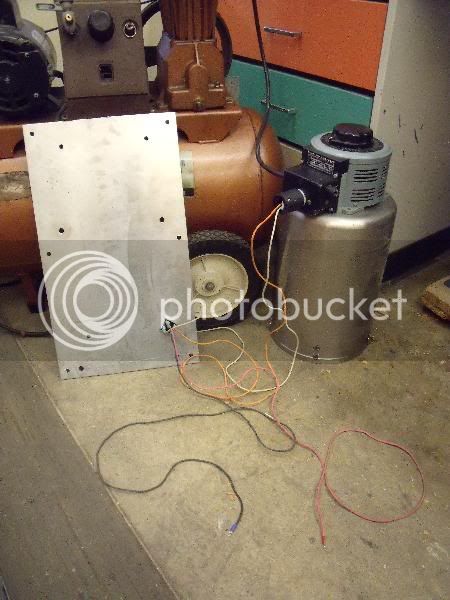
Here is the capacitor bank. Six 48.6 V, 165 F modules connected in series. I have only shocked myself three times.
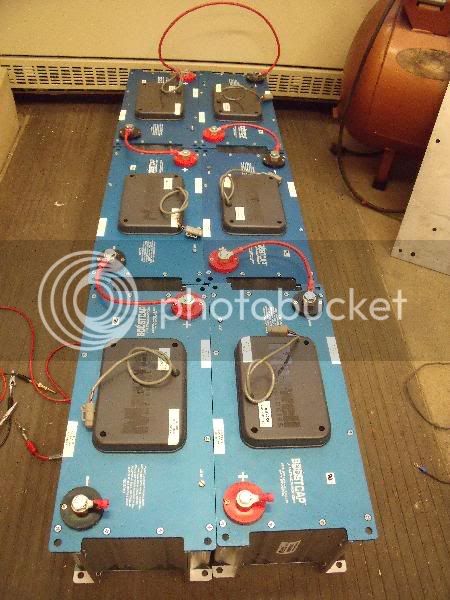
Here is the motor controller. It is a Hitachi X200 series, which will power a 1 hp, three phase motor.
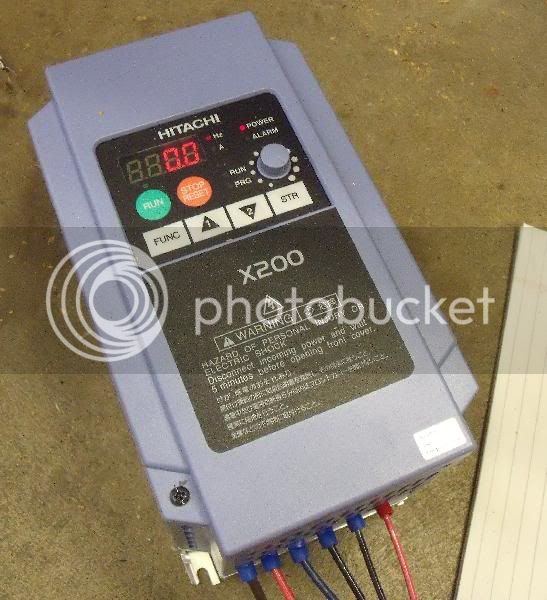
A closeup of the controller's input and output terminals shows why I selected this controller. From left to right, you have: 1) ground, 2) output phase 1, 3) output phase 2, 4) output phase 3, 5) - DC bus access, 6) + DC bus access.

Accessing the DC bus allows me to skip the controller's inverter and supply the controller with direct DC power. The ports are there for attaching a dynamic (resistor) brake, but I will use it to both power the motor and allow regen energy to flow back in to the capacitor bank. Here is the 1 hp (746 W) motor, with a 14 inch diameter cast iron v-belt pulley as a flywheel to store rotational energy:
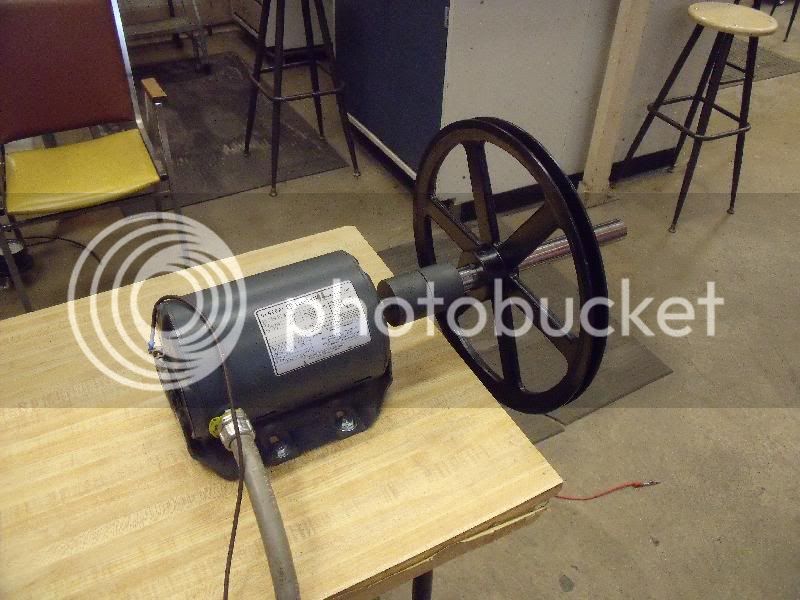
The motor controller lets me use a potentiometer to control the motor's speed by adjusting the input frequency. 60 Hz provides an axle rotation rate of 1725 rpm, according to the nameplate. I charge the caps up to 260 V, which is a voltage in the operating range of the controller (190 to 395 VDC):
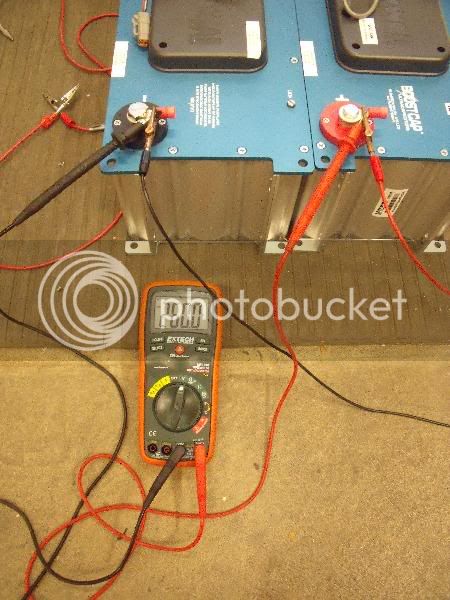
Here is a video of spinup to full speed (manual) and braking at about 15 Hz/s (programmed into the controller).
[youtube]FTfGhJ6LOXU[/youtube]
The table is not connected perfectly, so I get some shaking and hamonic vibration at about 25 Hz. The motor current for the same operation:
[youtube]NiM4e3-nMoU[/youtube]
The negative currents signify power heading back into the cap bank. I'm also using a ceramic heater element (cracked but still operational) to discharge the caps at the end of the day. It's rated at 1000 W.
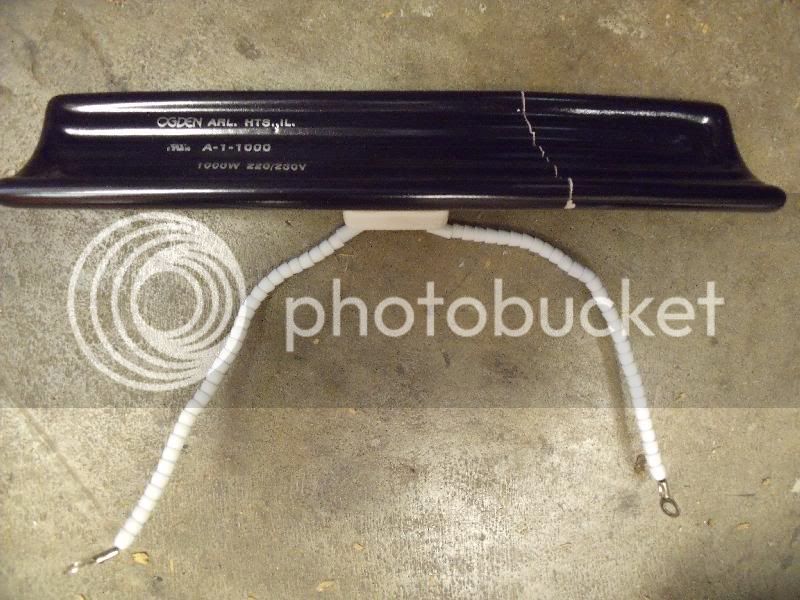
I'm mostly interested in finding out more about gensets... the car will need one of 25-35 kWe rating to fit in the trunk. I'd appreciate any ideas or feedback, and of course I'd welcome any questions or comments.
I've written a bit about this in other places, but a few years before I took my current position, my University was donated an EV-1 electric vehicle by General Motors. We have been trying very hard to get a place to work on the car, and may finally have caught a break for starting work this summer. The project I'm overseeing has a limited amount of funding, but it centers on converting the EV-1 into a serial hybrid with an ultracapacitor bank as its electric storage buffer. The main (average level) power source will be a genset powered by a to-be-determined fuel - likely biodiesel, which we are going to make by recovering waste vegetable oil from campus dining services. I am also considering ammonia fuel. In general, the energy flow plan is:
Liquid fuel --> Generator set --> Rectifier --> Ultracap Bank (389 V, 20.6 F) <--> AC motor controller <--> 3-ph, 103 kW motor
In order to get students interested in the project while our garage facility is prepared, I have used existing supplies (purchased and scavenged) to make a model of the proposed series drivetrain. Here is an introduction to the scaled setup.
The genset, when in operation, will provide either 1 or 3 phase AC power which must be rectified to DC. I have saved a 220V, 1.7 kVA variac from the junk heap to serve as this source of AC. It will deliver single phase AC in a voltage range of 0 to 220 VAC, RMS (the outlet's voltage level). I have connected its outputs (white and orange) to a 20 A rectifier, mounted on a large aluminum plate (heat sink). It provides DC output, which will give up to about 311 VDC when connected to a capacitive load.

Here is the capacitor bank. Six 48.6 V, 165 F modules connected in series. I have only shocked myself three times.

Here is the motor controller. It is a Hitachi X200 series, which will power a 1 hp, three phase motor.

A closeup of the controller's input and output terminals shows why I selected this controller. From left to right, you have: 1) ground, 2) output phase 1, 3) output phase 2, 4) output phase 3, 5) - DC bus access, 6) + DC bus access.

Accessing the DC bus allows me to skip the controller's inverter and supply the controller with direct DC power. The ports are there for attaching a dynamic (resistor) brake, but I will use it to both power the motor and allow regen energy to flow back in to the capacitor bank. Here is the 1 hp (746 W) motor, with a 14 inch diameter cast iron v-belt pulley as a flywheel to store rotational energy:

The motor controller lets me use a potentiometer to control the motor's speed by adjusting the input frequency. 60 Hz provides an axle rotation rate of 1725 rpm, according to the nameplate. I charge the caps up to 260 V, which is a voltage in the operating range of the controller (190 to 395 VDC):

Here is a video of spinup to full speed (manual) and braking at about 15 Hz/s (programmed into the controller).
[youtube]FTfGhJ6LOXU[/youtube]
The table is not connected perfectly, so I get some shaking and hamonic vibration at about 25 Hz. The motor current for the same operation:
[youtube]NiM4e3-nMoU[/youtube]
The negative currents signify power heading back into the cap bank. I'm also using a ceramic heater element (cracked but still operational) to discharge the caps at the end of the day. It's rated at 1000 W.

I'm mostly interested in finding out more about gensets... the car will need one of 25-35 kWe rating to fit in the trunk. I'd appreciate any ideas or feedback, and of course I'd welcome any questions or comments.


